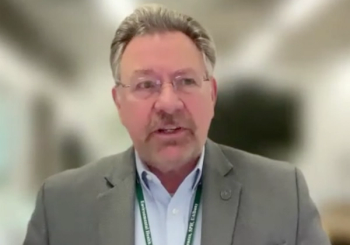
Networking and Educational Opportunities at Upcoming Eastern Analytical Symposium
The 2015 Eastern Analytical Symposium and Exposition (EAS) takes place November 16–18, in Somerset, New Jersey.
The 2015 Eastern Analytical Symposium and Exposition (EAS) takes place November 16–18, in Somerset, New Jersey. This year, attendees can expect plenty of educational and networking opportunities for analytical scientists. In advance of the event, Spectroscopy spoke to EAS President Oscar Liu about some of the most interesting and exciting activities scheduled for the event.
What is the significance of this year’s theme?
Liu: The 2015 EAS theme, “Analytical Innovation from Benchtop to Business,” highlights the impact that analytical chemistry has in generating business results. The analytical community has always been progressive and innovative. In analytical research laboratories, scientists identify new entities, create novel instruments, define scientific processes, and provide pioneering analytical services to tackle even the most complicated problems and challenges. These analytical innovations benefit myriad businesses, including instrument manufacturing, pharmaceutical development, new materials development, agrochemistry, law enforcement, art conservation, and more. The 2015 EAS conference will showcase these advancements in all areas of analytical science.
This year you have a Nobel laureate giving the keynote address. Can you tell us more about that?
Liu: We are honored and very excited that Professor Kurt Wüthrich, the 2002 Nobel Laureate in Chemistry, will deliver the 2015 EAS plenary lecture. Professor Wüthrich won the Nobel Prize for his development of nuclear magnetic resonance spectroscopy for determining the three-dimensional structure of biological macromolecules in solution. He is currently the Cecil H. and Ida M. Green Professor of Structural Biology at Scripps Research Institute in La Jolla, California, and a Professor of Biophysics at the Swiss Federal Institute of Technology, in Zurich, Switzerland. His research interests are in molecular structural biology, protein science, and structural genomics.
Professor Wüthrich has won numerous awards, received many honorary degrees, and given invited lectures throughout the world. The title of his plenary lecture is “From Basic Research in NMR to Use in Daily Human Life.” The lecture will take place on Monday, November 16, at 4:30 pm in the Grand Ball Room of the DoubleTree Hotel. It will be followed by a social mixer. The lecture and mixer are open to all EAS registrants and exhibitors.
What else is new or exciting about this year’s event?
Liu: 2015 is the International Year of Light, and the EAS conference is proud to be a sponsor. There are many technical sessions in the 2015 program dedicated to light and related technologies, such as “Celebrating the ‘International Year of Light’-How Spectroscopists Are Helping Save the World” and “Light and the Single Molecule-Viewing the Nanoworld.” Spectroscopy has always been an important area at EAS, and this year, with the International Year of Light upon us, it is even more special.
To tie into the theme of the 2015 EAS conference and to continue the educational mission of EAS, the dean of the Rutgers School of Business, Professor Lei Lei, has organized a session titled “Business Essentials for Technology Entrepreneurs” to help entrepreneurs and business managers. In it, attendees will learn the essentials of how to start up, manage, market, and lead a business in a technical field.
This year EAS published a call for proposals to solicit ideas for technical programs and short courses. We received very positive responses and accepted many of the proposals. Two technical sessions that will be of general interest are “3D Technology: Leveraging Today's Tools for Tomorrow's Applications” and “Analytical Testing for the Cannabis Industry: Consumer Safety vs. Regulatory Requirements.” Three-dimensional technology is applied to almost all fields, from space exploration to pharmaceutical and medical device industries, and offers incredible prospects in the analytical field. With the movement to legalize medical cannabis, the time has come to learn analytical testing, as well as safety and regulatory requirements, for the cannabis industry. The 2015 EAS conference will provide this session as a service to this newly formed industry.
EAS has long been concerned with its attendees’ employment, and we have provided an Employment Bureau to aid in connecting job seekers with potential employers. This year the Employment Bureau has entered the digital age by providing résumés in PDF format. The digital format makes it easier and faster for employers to find prospective applicants, through EAS’s secure portal.
We have also added a social-networking opportunity for all EAS attendees on Tuesday afternoon at a mixer from 4:00 to 5:30 pm in the exposition hall. The exposition hall will remain open during the mixer, providing attendees and exhibitors the opportunity to network in an informal setting, where foods and drink will be provided. In addition, there will be a special poster session during the mixer.
What is new in the spectroscopy programming for this year’s EAS conference? Why did you feel it was important to address the topics in those sessions?
Liu: A very special part of the program is the plenary lecture “From Basic Research in NMR to Use in Daily Human Life” by Professor Kurt Wüthrich. In addition to this presentation, the 2015 EAS conference features other sessions on nuclear magnetic resonance (NMR) spectroscopy. For example, the award session titled “EAS Award for Outstanding Achievements in Nuclear Magnetic Resonance Honoring Timothy Cross, Florida State University,” will provide insight into other biological uses of the technique. Sessions like “NMR Reaction Monitoring,” “New Developments in Quantitative NMR,” and “Macromolecular NMR: Probing Structure and Function” span the field.
As mentioned before, we are especially pleased to celebrate the International Year of Light at the 2015 EAS conference. Spectroscopy is ever growing. We are bringing its many developments and applications to the EAS audience this year. “Chemometrics Advances for Bioprocess Spectroscopic Monitoring and Control” will cover state-of-the-art research on the use of Raman, IR, and fluorescence spectroscopies in bioprocess monitoring. The novel technique of terahertz spectroscopy will be featured for the first time in the 2015 program, with applications in heritage conservation. Award sessions like the “EAS Award for Outstanding Achievements in Near-Infrared Spectroscopy Honoring Benoît Igne from GlaxoSmithKline;” the “New York Section of the Society for Applied Spectroscopy Gold Medal Award Honoring John A. Reffner, John Jay College;” and the “EAS Award for Outstanding Achievements in Chemometrics Honoring Peter D. Wentzell, Dalhousie University” will present the latest developments in theory and applications in spectroscopy.
The EAS conference has added more sessions on the growing field of forensic science. Audiences at the 2015 conference will learn about the latest developments in forensic microscopy, DNA frontiers, forensic toxicology, and the identification of trace analytes in forensic and environmental analysis.
Mass spectrometry is well represented at the 2015 EAS conference. Some of the world’s best mass spectrometrists will present at the award session “EAS Award for Outstanding Achievements in the Fields of Analytical Chemistry Honoring Chris Enke of the University of New Mexico.” A fine slate of talks will also be presented at the award session “EAS Award for Outstanding Achievements in Mass Spectrometry Honoring Emile A. Schweikert of Texas A&M University.” Aside from these award sessions, the EAS conference will feature sessions such as “Applications of Tandem Quadrupole Mass Spectrometry in Absolute Quantitation” and “New Approaches for Bioanalysis of Small Molecule and Biotherapeutics beyond Traditional LC–MS-MS.”
This year EAS introduces a new short course: “Atomic Spectroscopy-Applications of Elemental Analysis in the Pharmaceutical Industry.”
Are there also favorite topics returning to the program this year?
Liu: Spectroscopy has always been a strong component of the EAS program, and it continues to be. Besides the award sessions mentioned above, topics such as spectroscopic applications in the pharmaceutical industry, harnessing spectroscopy for inorganic impurity characterization, emerging trends in NIR, recent advances and applications of vibrational spectroscopy, and advances and applications in imaging science and technology attract a wide audience to the spectroscopy area of the EAS program.
In the short courses, while there are new topics on atomic spectroscopy and application of handheld vibrational spectrometers, many of the consistently favorite courses taught by the experts in these fields will return: “Chemometrics Without Equation,” “Handheld Vibrational Spectrometer,” and “Introduction to Vibrational Spectroscopy for Real Time Analysis.”
Newsletter
Get essential updates on the latest spectroscopy technologies, regulatory standards, and best practices—subscribe today to Spectroscopy.




